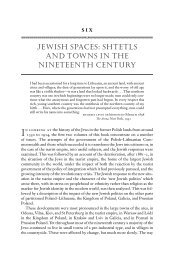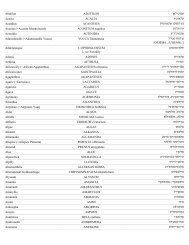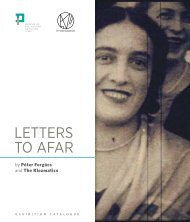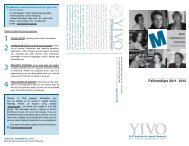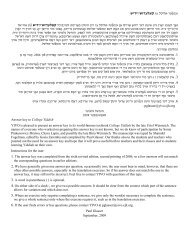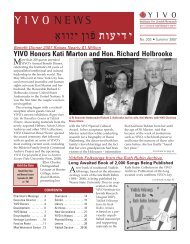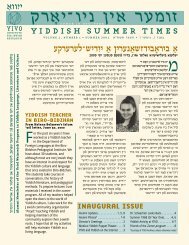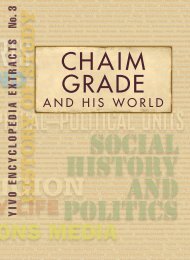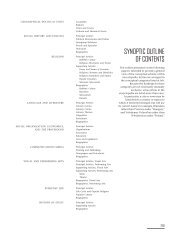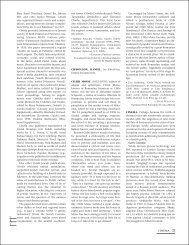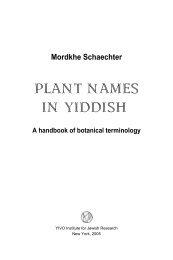Hebrew literature - YIVO Institute for Jewish Research
Hebrew literature - YIVO Institute for Jewish Research
Hebrew literature - YIVO Institute for Jewish Research
Create successful ePaper yourself
Turn your PDF publications into a flip-book with our unique Google optimized e-Paper software.
S<br />
R<br />
L<br />
dim and was indeed sent to the Austrian<br />
authorities. The detailed portrayal of the<br />
Hasidic lifestyle and the perfect imitation<br />
of their <strong>Hebrew</strong> style led some Hasidim<br />
into believing that this was an authentic<br />
Hasidic work instead of a venomous parody<br />
of their movement. Owing to the<br />
book’s sophisticated structural and linguistic<br />
features—it is written in the <strong>for</strong>m<br />
of a European epistolary novel—some<br />
critics regard it as <strong>Hebrew</strong> <strong>literature</strong>’s first<br />
novel. The work itself and the ensuing<br />
tempest that erupted in its wake became<br />
one of the main subjects in Perl’s second<br />
satirical work, BoÕen tsadik (Investigating<br />
a Righteous Man; 1838).<br />
The other prominent Galician satirist<br />
was YitsÕak Erter, who in 1822 took aim<br />
at the various strands of Orthodoxy in<br />
the <strong>for</strong>m of a series of acerbic allegorical<br />
tales. Following his death, the tales were<br />
collected and published as Ha-Tsofeh levet<br />
Yisra’el (The Watchman of the House<br />
of Israel; 1858). His most popular work,<br />
“Gilgul nefesh” (Transmigration of the<br />
Soul; 1845), describes the successive reincarnations<br />
of a soul; each of its 19 embodiments<br />
(among them, cantor, arendar,<br />
kabbalist, gravedigger, Hasidic master)<br />
represents a different dimension of the<br />
dark panorama of contemporary traditional<br />
<strong>Jewish</strong> life.<br />
In addition to satiric prose, the Galician<br />
Haskalah engaged in other literary activities,<br />
including translations or adaptations<br />
of original German fiction, the short<br />
story (<strong>for</strong> example, by Naftali Keller), as<br />
well as historical adventure stories involving<br />
intrepid travelers and explorers<br />
(by such writers as MenaÕem Mendel<br />
Lefin and Avraham Mendel Mohr).<br />
The Russian and Lithuanian<br />
Haskalah<br />
In the mid-nineteenth century, the Russian<br />
Empire replaced Galicia as the center<br />
of maskilic activity. This was mainly due<br />
to the prolific writing of YitsÕak Ber<br />
Levinzon (Ribal), a close associate of the<br />
Galician (<strong>Jewish</strong>) intelligentsia, who was<br />
supported by the tsarist authorities.<br />
Within the Russian Empire, the first<br />
true center of <strong>Hebrew</strong> maskilic <strong>literature</strong><br />
was in Lithuania, as reflected in the publication<br />
of the journal PirÕe tsafon, whose<br />
two editions appeared in Vilna in 1841<br />
and 1844, respectively. The most important<br />
poet of this period was Avraham Dov<br />
Lebensohn (Adam ha-Kohen), whose poetry<br />
collection Shire sefat kodesh (Poems in<br />
the Holy Tongue) was reprinted many<br />
times beginning in 1842. In these poems,<br />
as well as in his dramatic allegorical work<br />
Emet ve-emunah (Truth and Faith; 1867),<br />
Lebensohn succeeds in representing the<br />
Haskalah’s value system and the literary<br />
sensibilities of his time and place. His<br />
works reveal a belief in the <strong>for</strong>ce of divine<br />
wisdom that governs the world, reflected<br />
in depictions of light overcoming darkness;<br />
a contempt <strong>for</strong> the superstitions of<br />
traditional <strong>Jewish</strong> society; a preference <strong>for</strong><br />
the neoclassical, harmonizing literary<br />
<strong>for</strong>m somewhat removed from concrete<br />
reality and tending toward a more generalized<br />
observation of nature and man;<br />
and a commitment to the exaltation of<br />
the <strong>Hebrew</strong> language as the holy tongue<br />
with strict adherence to the usages of biblical<br />
<strong>Hebrew</strong>.<br />
In every respect, the poetry of Adam<br />
ha-Kohen’s son Mikhah Yosef Lebensohn<br />
(known as Mikhal) signifies a dramatic<br />
departure from his father’s rational, abstract,<br />
didactic world into an unabashedly<br />
romantic world. Mikhal’s lyrical and<br />
biblical poems are characterized by extraordinarily<br />
tangible representations of<br />
space and time on the part of their narrator,<br />
as well as the autobiographical feelings<br />
of the author, who alternates between<br />
his passion <strong>for</strong> life and his fear of<br />
death. His premature death in 1852 at age<br />
24 marked the end of this innovative approach,<br />
which was neither adopted nor<br />
integrated into contemporary <strong>Hebrew</strong> poetry<br />
(at that point in time it may not have<br />
been ready <strong>for</strong> such a move).<br />
Indeed, Mikhah Lebensohn’s close<br />
friend Yehudah Leib Gordon (Yalag) basically<br />
ignored the advances made by his<br />
colleague, choosing instead to “go backward<br />
in time.” Gordon began his career<br />
by focusing on the genre of the biblical<br />
epic, which was the hallmark of the <strong>Hebrew</strong><br />
Haskalah movement from its inception.<br />
He used this genre in his series of<br />
books on the life of King David (including<br />
the first book, Ahavat David u-Mikhal<br />
[The Love of David and Michal]; 1856).<br />
However, after completing this series he<br />
turned to the genre of parables, both original<br />
works and translations of other<br />
works, such as Mishle Yehudah (Fables of<br />
Judah; 1859). The combination of the<br />
sheer breadth of epic poems with the epigrammatic<br />
wit of parables prepared the<br />
groundwork <strong>for</strong> his historic and realistic<br />
narrative poems, by far his most important<br />
and most sophisticated genre. The<br />
best of these poems appeared in the<br />
1860s and 1870s, sterling examples of<br />
which include “Ben shine arayot” (Be-<br />
tween the Teeth of the Lions; 1868) and<br />
“Kotso shel yod” (The Tip of the Yud [<strong>Hebrew</strong><br />
letter]; 1878). However, by this time<br />
narrative fiction had replaced poetry as<br />
the characteristic <strong>for</strong>m of <strong>Hebrew</strong> <strong>literature</strong>—the<br />
result of a development that<br />
had also begun in the Lithuanian center<br />
of literary activity.<br />
In 1853, Avraham Mapu’s novel Ahavat<br />
Tsiyon (The Love of Zion) was published<br />
in Vilna. Its chaste language, descriptions<br />
of the Land of Israel’s natural environment,<br />
and especially its romantic plot set<br />
during biblical times enchanted generations<br />
of readers and marked a significant<br />
turning point in <strong>Hebrew</strong> prose. Its appearance<br />
served as a catalyst <strong>for</strong> the protracted<br />
debate about the place of the<br />
novel in <strong>Hebrew</strong> <strong>literature</strong>—a polemic<br />
that eventually determined the centrality<br />
of the novel as a “mirror of reality,” assuring<br />
its place as the natural heir to the traditional<br />
biblical epic.<br />
In the course of this polemic, <strong>Hebrew</strong><br />
literary criticism also matured. Two of its<br />
earliest and most eloquent representatives<br />
were Avraham Uri Kovner and<br />
Avraham Ya‘akov Paperna, both of whom<br />
later wrote in Russian. Aside from Mapu’s<br />
books, Eugène Sue’s novel Les Mystères de<br />
Paris (The Mysteries of Paris; 1842–1843),<br />
a tense and complex melodrama first<br />
translated into <strong>Hebrew</strong> by Kalman Shulman<br />
in 1857, entertained its readership<br />
and suggested the possibilities of novelistic<br />
expression in <strong>Hebrew</strong>. With the publication<br />
in 1857 of ‘Ayit tsavu‘a (The Hypocrite),<br />
Mapu himself quickly changed<br />
course, turning from biblical themes to<br />
criticism of contemporary <strong>Jewish</strong> existence<br />
in Lithuania, thereby leading the<br />
way <strong>for</strong> a long list of writers. Indeed, the<br />
ideological realistic novel typical of the<br />
1860s and 1870s centered on the struggle<br />
of maskilic “sons of light” to bring<br />
enlightenment to the <strong>Jewish</strong> environment,<br />
which was depicted as dark and<br />
fanatical. Prominent examples include<br />
Sholem Yankev Abramovitsh’s (Mendele<br />
Moykher-S<strong>for</strong>im’s) Limdu hetev (Learn<br />
Well [1862]; expanded and developed as<br />
Ha-Avot veha-banim [The Fathers and the<br />
Sons; 1868]), Perets Smolenskin’s Kevurat<br />
Õamor (A Donkey’s Burial; 1873 [published<br />
in book <strong>for</strong>m 1874]), and Re’uven<br />
Asher Braudes’s Ha-Dat veha-Õayim (Religion<br />
and Life; 1876–1878).<br />
Aside from the novel, other genres of<br />
<strong>Hebrew</strong> prose also came to the <strong>for</strong>e. Yehudah<br />
Leib Gordon and Mordekhai David<br />
Brandstetter developed the short story<br />
HEBREW LITERATURE 699



